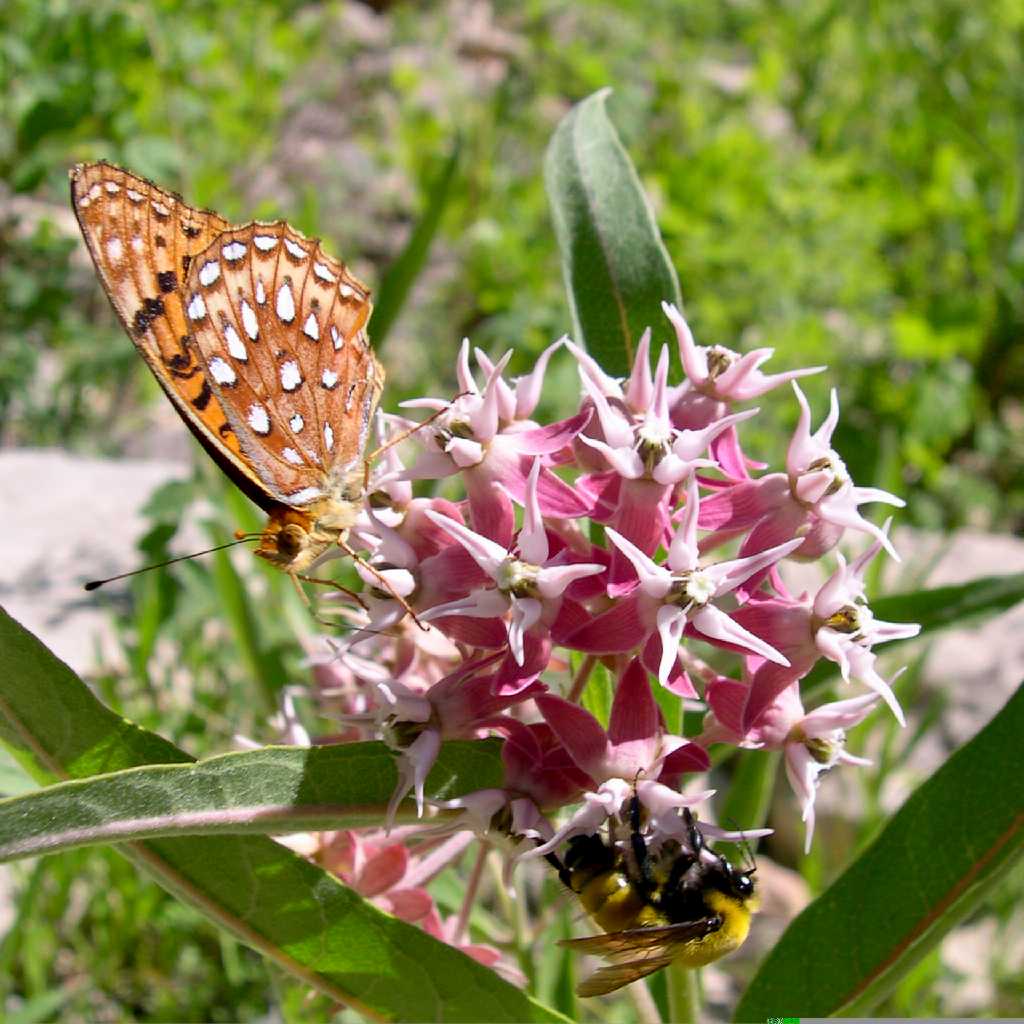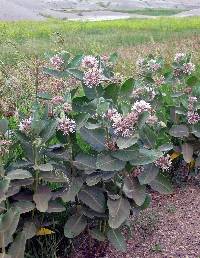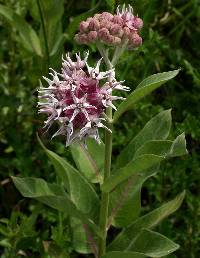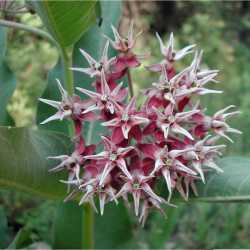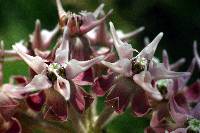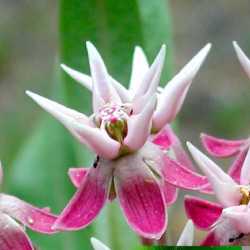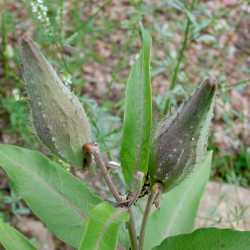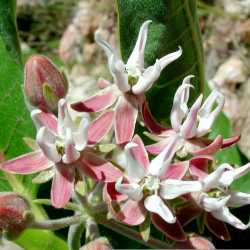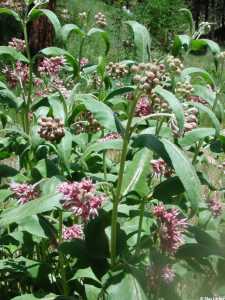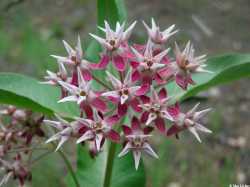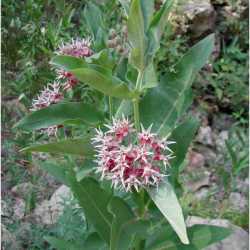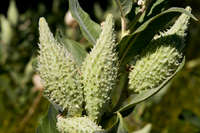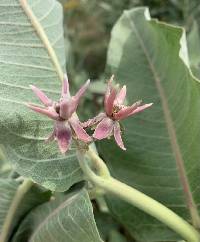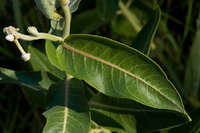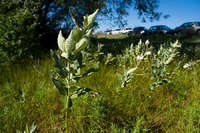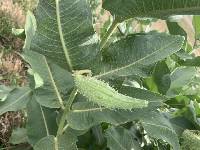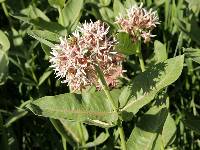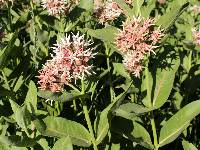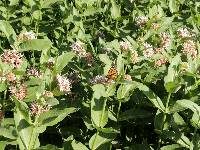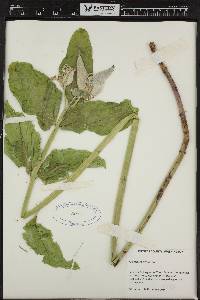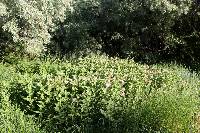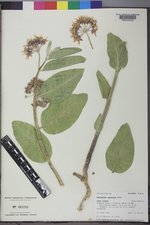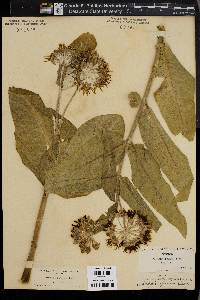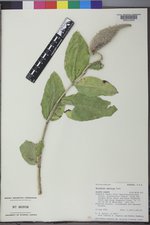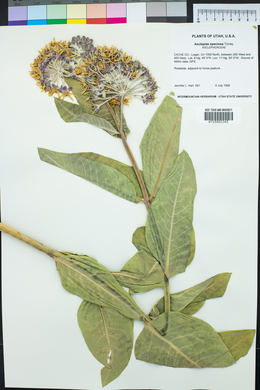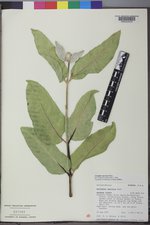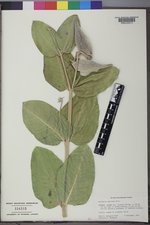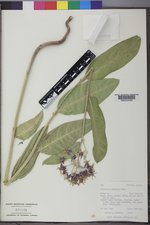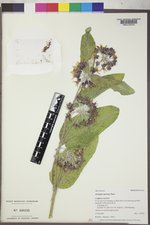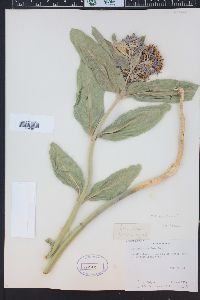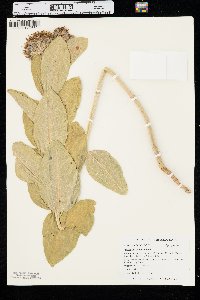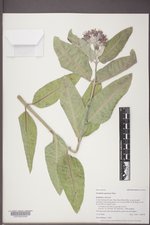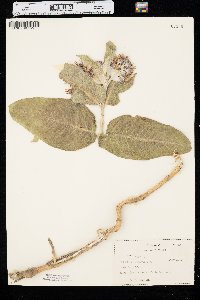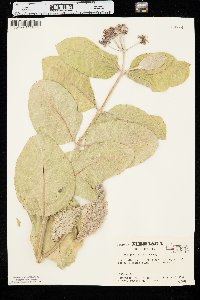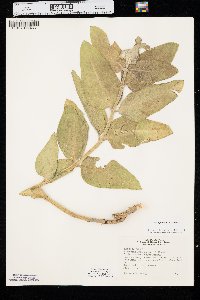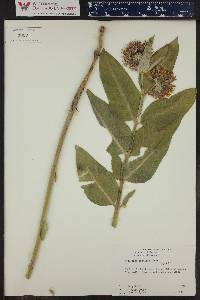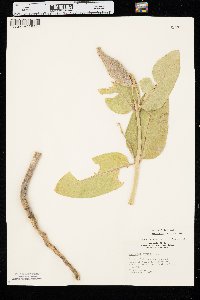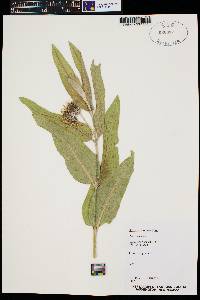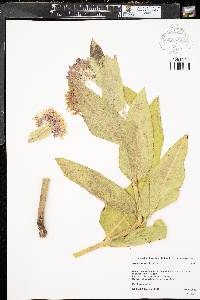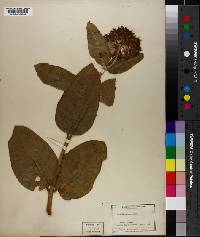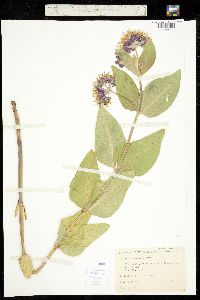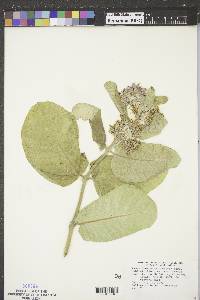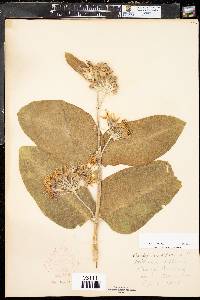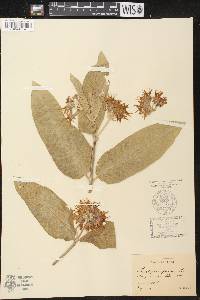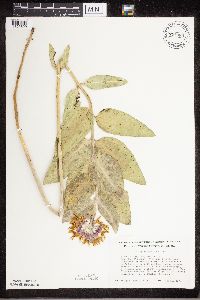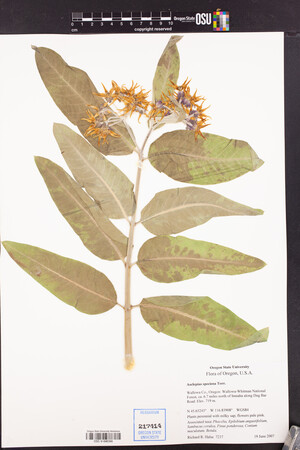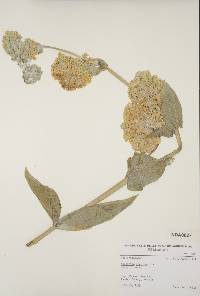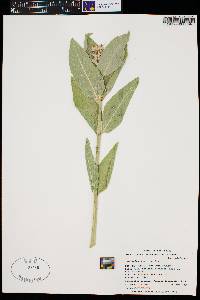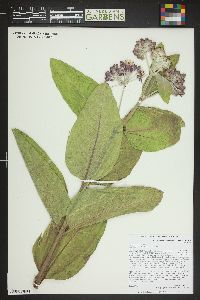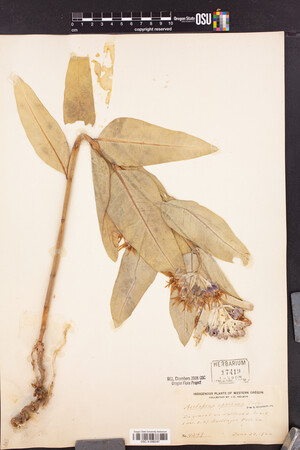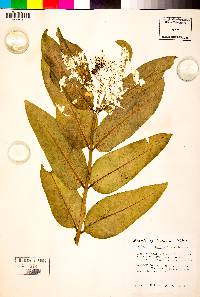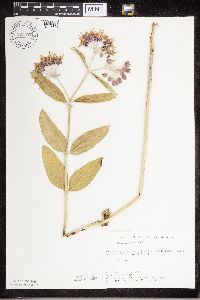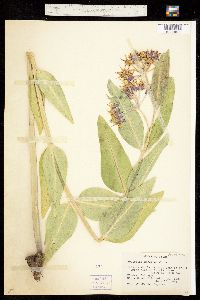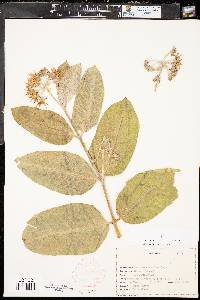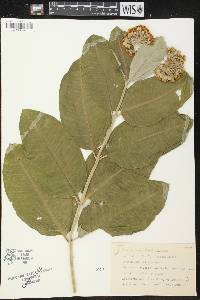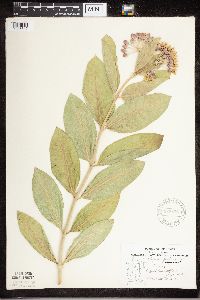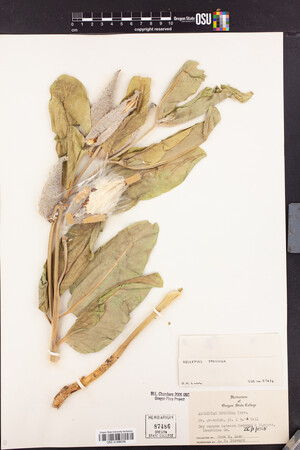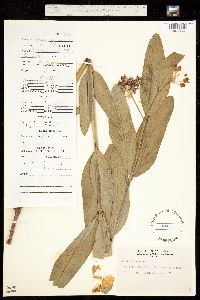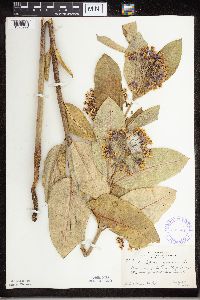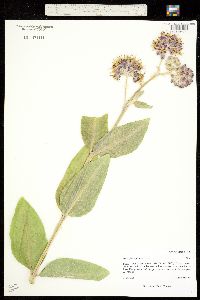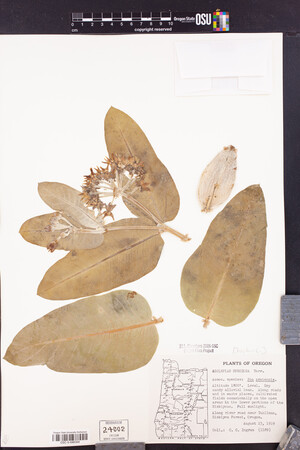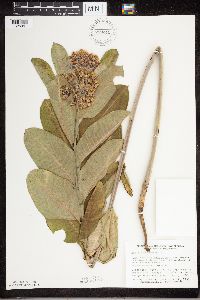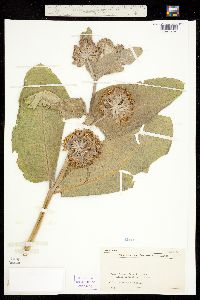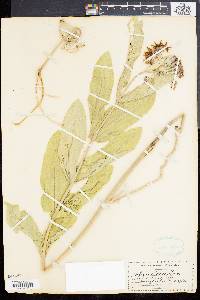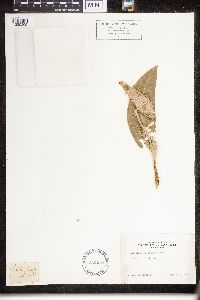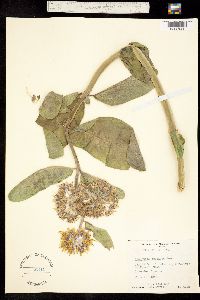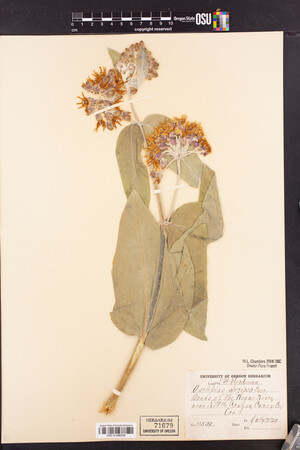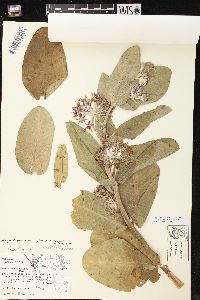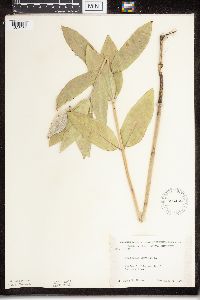
|
|
|
|
Family: Apocynaceae
Showy Milkweed, more... (es: talayote)
[Asclepias giffordii Eastw.] |
Plant: perennial herb; stems erect, unbranched, 40-100 cm tall, densely white woolly to pubescent when young, more or less glabrate below Leaves: opposite, the petioles 4-10 mm long, the blades ovate to broadly lanceolate, 7-20 cm long, 2-9 cm broad, obtuse to broadly rounded or rarely subcordate at the base, attenuate to an obtuse or acute apex, pubescent above, rather woolly beneath INFLORESCENCE: UMBELS lateral at the upper nodes, 4-9 cm broad, the peduncles 2-11 cm long Flowers: large; calyx lobes 4-6 mm long; corolla purplish, the lobes 9-11 mm long; hoods drying yellow-brown, ascending, ovoid-attenuate, more or less abruptly narrowed near the middle, 10-14 mm long, 5-10 mm longer than the gynostegium, the horns attached near the base of the hoods, radially flat, exserted 1-2 mm and incurved over the stigma head; anther wings 2.4-3 mm long; corpusculum 0.7-0.8 mm long, the pollinia 1.3-1.6 mm long Fruit: FOLLICLES erect on deflexed pedicels, 11-13 cm long, the surface typically with soft, elongate tubercles Misc: Mountain meadows and open woodlands, streamsides, spreading to roadsides and other disturbed sites; 1500-2600 m (5000-8500 ft); Jun-Aug REFERENCES: Sundell, Eric. 1994. Asclepiadaceae. J. Ariz. - Nev. Acad. Sci. Volume 27, 169-187. Sundell 1993, Woodson 1954, Nabhan 2015 Duration: Perennial Nativity: Native Lifeform: Forb/Herb General: Stout, pubescent perennial herbs, 40-100 cm tall; stems erect, unbranched, densely white woolly to pubescent when young, glabrate below; plants with milky sap. Leaves: Opposite and petiolate, the petioles 4-10 mm long; blades ovate to broadly lanceolate, 7-20 cm long, 2-9 cm broad, obtuse to broadly rounded or rarely subcordate at base, attenuate to acute at apex, upper surface pubescent, lower surface woolly. Flowers: Large and bright pink, in solitary umbels, 4-9 cm wide, lateral at upper nodes, on peduncles 2-11 cm long; corolla purplish, the lobes 9-11 mm long; hoods drying to yellow-brown, ascending, ovoid-attenuate, more or less abruptly narrowed near middle, 10-14 mm long, 5-10 mm longer than gynostegium; horns attached near base of hoods, radially flat, exserted 1-2 mm and incurved over the stigma head; calyx lobes 4-6 mm long. Fruits: Follicles erect on deflexed pedicels, 11-13 cm long, the surface covered with soft, elongate tubercles. Ecology: Found in meadows and open woodlands, along streams and in more mesic disturbed sites from 5,000-8,500 ft (1524-2591 m); flowers May-September. Distribution: Widespread across the w US into s Manitoba and British Columbia, from MN and the midwest to the Pacific coast; south to TX and n MEX. Notes: This showy, pink-flowered milkweed is distinctive as having the largest flowers of any species of Asclepias in North America. It was described by Woodson in 1954 as being widely tolerant to habitat, even weedy, in cultivated fields, roadsides and railways. This species is known to hybridize with A. syriaca. Average around 70,250 seeds per pound. It is a known monarch host plant. Ethnobotany: Used as an eye medicine; used roots for stomachache, for warts, venereal diseases, as an emetic; externally for rheumatism, as healing agent for sores, for cough; decoction of seeds for drawing poison from snakebites; for tuberculosis, for diarrhea, as an antiseptic; eaten as a candy; the immature fruits were peeled and the inner layer eaten along with young buds; stalks were cooked, flowers boiled, seeds eaten raw; also used to make string. Etymology: Asclepias is named for Asklepios, the Greek god of healing; speciosa means showy. Synonyms: Asclepias giffordii Editor: SBuckley 2010, 2014, AHazelton 2015 Colonial by roots; stem stout, erect, to 1 m, hairy; lvs ovate to lance-ovate or ovate-oblong, 10-15 cm, broadly rounded or subcordate at base, hairy beneath; petioles
3-6 mm; umbels usually few, 5-7 cm wide; peduncles stout, 3-7 cm; cor greenish-purple, its lobes 10-15 mm; hoods 10-15 mm, abruptly narrowed below the middle to a linear-oblong tip; horns short, inflexed; fr densely tomentose and beset with soft filiform processes; 2n=22. Moist prairies; Man. to Minn., Io., and Okla., w. to B.C. and Calif. July, Aug. Gleason, Henry A. & Cronquist, Arthur J. 1991. Manual of vascular plants of northeastern United States and adjacent Canada. lxxv + 910 pp. ©The New York Botanical Garden. All rights reserved. Used by permission. |
|
|
|
This project was made possible in part by the Institute of Museum and Library Services [MG-70-19-0057-19].
Powered by Symbiota

